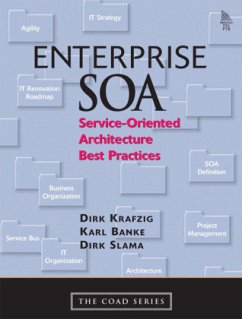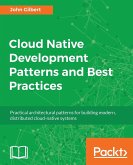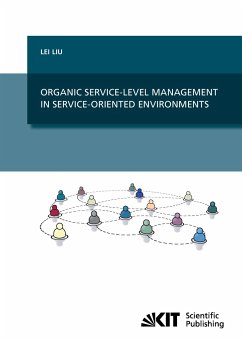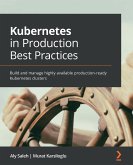Learn to apply the significant promise of SOA to overcome the formidable challenges of distributed enterprise development.
Avoid common pitfalls in distributed systems design by applying the proven concepts of SOA
SOA helps IT organizations reduce risk, save time, lower costs, and deliver better, more professional services
Detailed vertical case studies and hands-on insight based on the author team's extensive experience in a wide variety of industries
This book spells out guidelines and strategies for successfully using Service Oriented Architecture (SOA) in large-scale projects. SOA represents the latest paradigm in distributed computing and middleware development. However, SOA is not a revolution, but rather an evolution in software architecture. SOA is a collection of best practice software construction principles accompanied by proven methodologies in development and project management. This book is unique in that it offers a pragmatic approach to the topic. The authors borrow from their more than forty years of collective enterprise experience, and offer a frank discussion of the challenges associated with adopting SOA. They also help readers ensure that their organization does not become too closely tied to a specific technology. The result is a detailed introduction to the topic and an architectural blueprint for implementing SOA. Product Description
This book spells out guidelines and strategies for successfully using ServiceOriented Architecture (SOA) in large-scale projects. SOA represents the latestparadigm in distributed computing and middleware development. However,SOA is not a revolution, but rather an evolution in software architecture. SOAis a collection of best practice software construction principles accompanied byproven methodologies in development and project management.This book is unique in that it offers a pragmatic approach to the topic. Theauthors borrow from their more than forty years of collective enterpriseexperience, and offer a frank discussion of the challenges associated withadopting SOA. They also help readers ensure that their organization does notbecome too closely tied to a specific technology. The result is a detailedintroduction to the topic and an architectural blueprint for implementing SOA.
Backcover
By delivering SAP's next-generation applications based on a Services-Oriented Architecture, SAP is at the forefront of making Web services work for the enterprise. The Enterprise Services Architecture enables unprecedented flexibility in business process deployment, allowing companies to execute and innovate end-to-end processes across departments and companies, with minimum disruption to other systems and existing IT investments. This strategy comes to life with SAP NetWeaver, which is the technological foundation of the Enterprise Services Architecture. It provides easy integration of people, information, and systems in heterogeneous IT environments and provides a future proof application platform. Enterprise SOA provides readers with the architectural blueprints and SOA-driven project management strategies that are required to successfully adopt SOA on an enterprise level.
-Dr. Peter Graf, SVP Product Marketing, SAP
The SOA principles outlined in this book enable enterprises to leverage robust and proven middleware platforms, including CORBA, to build flexible and business-oriented service architectures. The authors also clearly describe the right strategies for using Model Driven Architecture (MDA) to manage SOA Service Repositories in a platform-independent way, enabling enterprises to better address the problem of heterogeneity at many levels. The Object Management Group was created just to address this central problem of integration in the face of constantly changing heterogeneity and platform churn, so I strongly recommend this book for the bookshelf of every enterprise architect and developer.
-Richard Mark Soley, Ph.D. chairman and chief executive officer, Object Management Group, Inc.
Enterprise SOA provides strategies that help large enterprises to increase the agility of their IT systems-one of the most pressing issues of contemporary IT. Covering both a business and architectural view, these strategies aim to promote the implementation of an IT infrastructure that can serve as a base for the development of truly flexible business processes. This book covers its subject with great profoundness based on real world evidence. It is in the interest of everybody involved with software architecture-particularly for anybody who intends to establish a Service-Oriented Architecture-to read this book.
-Dr. Helge Heß, director Business Process Management, IDS Scheer AG
...The SOA principles described in this book are the foundation on which enterprises can build an IT architecture that will satisfy today's most important IT requirements-agility and flexibility-at affordable costs...
-Martin Frick, Head of IT, Winterthur Group
Providing the roadmap for delivering on the promise of Service-Oriented Architecture
Enterprise SOA presents a complete roadmap for leveraging the principles of Service-Oriented Architectures to reduce cost and risk, improve efficiency and agility, and liberate your organization from the vagaries of changing technology.
Benefit from the lessons of four enterprise-level SOA case studies from Credit Suisse, Halifax Bank of Scotland, and other world-class enterprises
Make your business technology independent and manage infrastructure heterogeneity by focusing on architecture, not specific implementation techniques
Recognize the technical and nontechnical success factors for SOA in the enterprise
Define and communicate the economic value proposition of an SOA
Apply pragmatic design principles to solve the problems of data and process integrity in an SOA environment
Whether you're a manager, architect, analyst, or developer, if you must drive greater value from IT services, Enterprise SOA will show you how-from start to finish.
About the Authors DIRK KRAFZIG, KARL BANKE, and DIRK SLAMA have many years of experience in enterprise IT, including project management and distributed system design for large-scale projects. This book subsumes the knowledge of Service-Oriented Architectures that they have acquired since 1998, when they made their first steps toward this new architecture paradigm.
About the Web Site Web site www.enterprise-soa.com , provides a variety of supplemental material, including: articles, examples, and additional case studies.
© Copyright Pearson Education. All rights reserved.
Foreword.
Reader's Guide.
Chapter 1 - An Enterprise IT Renovation Roadmap.
1.1 - Agony Versus Agility.
1.2 - Enterprise Software Is a Different Animal.
1.3 - The Importance of Enterprise Software Architectures.
1.4 - The Requirements for an Enterprise Software Architecture.
1.5 - The Relation of Enterprise Architecture and Enterprise Standards.
1.6 - Organizational Aspects.
1.7 - Lifelong Learning.
1.8 - The Enterprise IT Renovation Roadmap.
Chapter 2 - Evolution of the Service Concept.
2.1 - Milestones of Enterprise Computing.
2.2 - Programming Paradigms
2.3 - Distributed Computing
2.4 - Business Computing
2.5 - Conclusion
References
URLs
Chapter 3 - Inventory of Distributed Computing Concepts.
3.1 - Heterogeneity of Communication Mechanisms
3.2 - Communication Middleware
3.3 - Synchrony
3.4 - Interface Versus Payload Semantics
3.5 - Tight Versus Loose Coupling
3.6 - Conclusion
References
URLs
PART I - ARCHITECTURAL ROADMAP.
Chapter 4 - Service-Oriented Architectures.
4.1 - What Is a Software Architecture?
4.2 - What Is a Service-Oriented Architecture?
4.3 - Elements of a Service-Oriented Architecture
4.4 - Conclusion
References
URLs
Chapter 5 - Services as Building Blocks.
5.1 - Service Types
5.2 - Layers on the Enterprise Level
5.3 - Conclusion
References
Chapter 6 - The Architectural Roadmap.
6.1 - The Architectural Roadmap
6.2 - Fundamental SOA
6.3 - Networked SOA
6.4 - Process-Enabled SOA
6.5 - Conclusion
Chapter 7 - SOA and Business Process Management.
7.1 - Introduction to BPM
7.2 - BPM and the Process-Enabled SOA
7.3 - Conclusion
References
URLs
Chapter 8 - Managing Process Integrity.
8.1 - Data Versus Process Integrity
8.2 - Technical Concepts and Solutions
8.3 - Recommendations for SOA Architects
8.4 - Conclusion
References
Chapter 9 - Infrastructure of the Service Bus.
9.1 - Software Buses and the Service Bus
9.2 - Logging and Auditing
9.3 - Availability and Scalability
9.4 - Securing SOAs
9.5 - Conclusion
References
URLs
Chapter 10 - SOA in Action.
10.1 - Building Web Applications
10.2 - Enterprise Application Integration
10.3 - Business-to-Business
10.4 - Fat Clients
10.5 - Designing for Small Devices
10.6 - Multi-Channel Applications
10.7 - Conclusion
References
URLs
PART II - ORGANIZATIONAL ROADMAP.
Chapter 11 - Motivation and Benefits.
11.1 - The Enterprise Perspective
11.2 - The Personal Perspective
11.3 - Conclusion
References
URLs
Chapter 12 - The Organizational SOA Roadmap.
12.1 - Stakeholders and Potential Conflicts of Interest
12.2 - The Organizational SOA Roadmap
12.3 - Four Pillars for Success
12.4 - An Ideal World
12.5 - The Real World-Organization-Wide Standards
12.6 - Recommendations for the SOA Protagonist
12.7 - Conclusion
URLs
Chapter 13 - SOA-Driven Project Management.
13.1 - Established Project Management Methodologies
13.2 - SOA-Driven Project Management
13.3 - Configuration Management
13.4 - Testing
13.5 - Conclusion
References
URLs
PART III - REAL-WORLD EXPERIENCE.
Chapter 14 - Deutsche Post AG Case Study.
14.1 - Project Scope
14.2 - Implementation
14.3 - Technology
14.4 - Lessons Learned, Benefits, and Perspectives
References
Links
Chapter 15 - Winterthur Case Study.
15.1 - Project Scope
15.2 - Implementation
15.3 - Technology
15.4 - Lessons Learned, Benefits, and Perspectives
Chapter 16 - Credit Suisse Case Study.
16.1 - Project Scope
16.2 - Implementation
16.3 - Technology
16.4 - Lessons Learned, Benefits, and Perspectives
References
Chapter 17 - Halifax Bank Of Scotland: IF.com.
17.1 - Project Scope
17.2 - Implementation
17.3 - Technology
17.4 - Lessons Learned, Benefits, and Perspectives
URLs
Index.
By delivering SAP's next-generation applications based on a Services-Oriented Architecture, SAP is at the forefront of making Web services work for the enterprise. The Enterprise Services Architecture enables unprecedented flexibility in business process deployment, allowing companies to execute and innovate end-to-end processes across departments and companies, with minimum disruption to other systems and existing IT investments. This strategy comes to life with SAP NetWeaver, which is the technological foundation of the Enterprise Services Architecture. It provides easy integration of people, information, and systems in heterogeneous IT environments and provides a future proof application platform. Enterprise SOA provides readers with the architectural blueprints and SOA-driven project management strategies that are required to successfully adopt SOA on an enterprise level.
Avoid common pitfalls in distributed systems design by applying the proven concepts of SOA
SOA helps IT organizations reduce risk, save time, lower costs, and deliver better, more professional services
Detailed vertical case studies and hands-on insight based on the author team's extensive experience in a wide variety of industries
This book spells out guidelines and strategies for successfully using Service Oriented Architecture (SOA) in large-scale projects. SOA represents the latest paradigm in distributed computing and middleware development. However, SOA is not a revolution, but rather an evolution in software architecture. SOA is a collection of best practice software construction principles accompanied by proven methodologies in development and project management. This book is unique in that it offers a pragmatic approach to the topic. The authors borrow from their more than forty years of collective enterprise experience, and offer a frank discussion of the challenges associated with adopting SOA. They also help readers ensure that their organization does not become too closely tied to a specific technology. The result is a detailed introduction to the topic and an architectural blueprint for implementing SOA. Product Description
This book spells out guidelines and strategies for successfully using ServiceOriented Architecture (SOA) in large-scale projects. SOA represents the latestparadigm in distributed computing and middleware development. However,SOA is not a revolution, but rather an evolution in software architecture. SOAis a collection of best practice software construction principles accompanied byproven methodologies in development and project management.This book is unique in that it offers a pragmatic approach to the topic. Theauthors borrow from their more than forty years of collective enterpriseexperience, and offer a frank discussion of the challenges associated withadopting SOA. They also help readers ensure that their organization does notbecome too closely tied to a specific technology. The result is a detailedintroduction to the topic and an architectural blueprint for implementing SOA.
Backcover
By delivering SAP's next-generation applications based on a Services-Oriented Architecture, SAP is at the forefront of making Web services work for the enterprise. The Enterprise Services Architecture enables unprecedented flexibility in business process deployment, allowing companies to execute and innovate end-to-end processes across departments and companies, with minimum disruption to other systems and existing IT investments. This strategy comes to life with SAP NetWeaver, which is the technological foundation of the Enterprise Services Architecture. It provides easy integration of people, information, and systems in heterogeneous IT environments and provides a future proof application platform. Enterprise SOA provides readers with the architectural blueprints and SOA-driven project management strategies that are required to successfully adopt SOA on an enterprise level.
-Dr. Peter Graf, SVP Product Marketing, SAP
The SOA principles outlined in this book enable enterprises to leverage robust and proven middleware platforms, including CORBA, to build flexible and business-oriented service architectures. The authors also clearly describe the right strategies for using Model Driven Architecture (MDA) to manage SOA Service Repositories in a platform-independent way, enabling enterprises to better address the problem of heterogeneity at many levels. The Object Management Group was created just to address this central problem of integration in the face of constantly changing heterogeneity and platform churn, so I strongly recommend this book for the bookshelf of every enterprise architect and developer.
-Richard Mark Soley, Ph.D. chairman and chief executive officer, Object Management Group, Inc.
Enterprise SOA provides strategies that help large enterprises to increase the agility of their IT systems-one of the most pressing issues of contemporary IT. Covering both a business and architectural view, these strategies aim to promote the implementation of an IT infrastructure that can serve as a base for the development of truly flexible business processes. This book covers its subject with great profoundness based on real world evidence. It is in the interest of everybody involved with software architecture-particularly for anybody who intends to establish a Service-Oriented Architecture-to read this book.
-Dr. Helge Heß, director Business Process Management, IDS Scheer AG
...The SOA principles described in this book are the foundation on which enterprises can build an IT architecture that will satisfy today's most important IT requirements-agility and flexibility-at affordable costs...
-Martin Frick, Head of IT, Winterthur Group
Providing the roadmap for delivering on the promise of Service-Oriented Architecture
Enterprise SOA presents a complete roadmap for leveraging the principles of Service-Oriented Architectures to reduce cost and risk, improve efficiency and agility, and liberate your organization from the vagaries of changing technology.
Benefit from the lessons of four enterprise-level SOA case studies from Credit Suisse, Halifax Bank of Scotland, and other world-class enterprises
Make your business technology independent and manage infrastructure heterogeneity by focusing on architecture, not specific implementation techniques
Recognize the technical and nontechnical success factors for SOA in the enterprise
Define and communicate the economic value proposition of an SOA
Apply pragmatic design principles to solve the problems of data and process integrity in an SOA environment
Whether you're a manager, architect, analyst, or developer, if you must drive greater value from IT services, Enterprise SOA will show you how-from start to finish.
About the Authors DIRK KRAFZIG, KARL BANKE, and DIRK SLAMA have many years of experience in enterprise IT, including project management and distributed system design for large-scale projects. This book subsumes the knowledge of Service-Oriented Architectures that they have acquired since 1998, when they made their first steps toward this new architecture paradigm.
About the Web Site Web site www.enterprise-soa.com , provides a variety of supplemental material, including: articles, examples, and additional case studies.
© Copyright Pearson Education. All rights reserved.
Foreword.
Reader's Guide.
Chapter 1 - An Enterprise IT Renovation Roadmap.
1.1 - Agony Versus Agility.
1.2 - Enterprise Software Is a Different Animal.
1.3 - The Importance of Enterprise Software Architectures.
1.4 - The Requirements for an Enterprise Software Architecture.
1.5 - The Relation of Enterprise Architecture and Enterprise Standards.
1.6 - Organizational Aspects.
1.7 - Lifelong Learning.
1.8 - The Enterprise IT Renovation Roadmap.
Chapter 2 - Evolution of the Service Concept.
2.1 - Milestones of Enterprise Computing.
2.2 - Programming Paradigms
2.3 - Distributed Computing
2.4 - Business Computing
2.5 - Conclusion
References
URLs
Chapter 3 - Inventory of Distributed Computing Concepts.
3.1 - Heterogeneity of Communication Mechanisms
3.2 - Communication Middleware
3.3 - Synchrony
3.4 - Interface Versus Payload Semantics
3.5 - Tight Versus Loose Coupling
3.6 - Conclusion
References
URLs
PART I - ARCHITECTURAL ROADMAP.
Chapter 4 - Service-Oriented Architectures.
4.1 - What Is a Software Architecture?
4.2 - What Is a Service-Oriented Architecture?
4.3 - Elements of a Service-Oriented Architecture
4.4 - Conclusion
References
URLs
Chapter 5 - Services as Building Blocks.
5.1 - Service Types
5.2 - Layers on the Enterprise Level
5.3 - Conclusion
References
Chapter 6 - The Architectural Roadmap.
6.1 - The Architectural Roadmap
6.2 - Fundamental SOA
6.3 - Networked SOA
6.4 - Process-Enabled SOA
6.5 - Conclusion
Chapter 7 - SOA and Business Process Management.
7.1 - Introduction to BPM
7.2 - BPM and the Process-Enabled SOA
7.3 - Conclusion
References
URLs
Chapter 8 - Managing Process Integrity.
8.1 - Data Versus Process Integrity
8.2 - Technical Concepts and Solutions
8.3 - Recommendations for SOA Architects
8.4 - Conclusion
References
Chapter 9 - Infrastructure of the Service Bus.
9.1 - Software Buses and the Service Bus
9.2 - Logging and Auditing
9.3 - Availability and Scalability
9.4 - Securing SOAs
9.5 - Conclusion
References
URLs
Chapter 10 - SOA in Action.
10.1 - Building Web Applications
10.2 - Enterprise Application Integration
10.3 - Business-to-Business
10.4 - Fat Clients
10.5 - Designing for Small Devices
10.6 - Multi-Channel Applications
10.7 - Conclusion
References
URLs
PART II - ORGANIZATIONAL ROADMAP.
Chapter 11 - Motivation and Benefits.
11.1 - The Enterprise Perspective
11.2 - The Personal Perspective
11.3 - Conclusion
References
URLs
Chapter 12 - The Organizational SOA Roadmap.
12.1 - Stakeholders and Potential Conflicts of Interest
12.2 - The Organizational SOA Roadmap
12.3 - Four Pillars for Success
12.4 - An Ideal World
12.5 - The Real World-Organization-Wide Standards
12.6 - Recommendations for the SOA Protagonist
12.7 - Conclusion
URLs
Chapter 13 - SOA-Driven Project Management.
13.1 - Established Project Management Methodologies
13.2 - SOA-Driven Project Management
13.3 - Configuration Management
13.4 - Testing
13.5 - Conclusion
References
URLs
PART III - REAL-WORLD EXPERIENCE.
Chapter 14 - Deutsche Post AG Case Study.
14.1 - Project Scope
14.2 - Implementation
14.3 - Technology
14.4 - Lessons Learned, Benefits, and Perspectives
References
Links
Chapter 15 - Winterthur Case Study.
15.1 - Project Scope
15.2 - Implementation
15.3 - Technology
15.4 - Lessons Learned, Benefits, and Perspectives
Chapter 16 - Credit Suisse Case Study.
16.1 - Project Scope
16.2 - Implementation
16.3 - Technology
16.4 - Lessons Learned, Benefits, and Perspectives
References
Chapter 17 - Halifax Bank Of Scotland: IF.com.
17.1 - Project Scope
17.2 - Implementation
17.3 - Technology
17.4 - Lessons Learned, Benefits, and Perspectives
URLs
Index.
By delivering SAP's next-generation applications based on a Services-Oriented Architecture, SAP is at the forefront of making Web services work for the enterprise. The Enterprise Services Architecture enables unprecedented flexibility in business process deployment, allowing companies to execute and innovate end-to-end processes across departments and companies, with minimum disruption to other systems and existing IT investments. This strategy comes to life with SAP NetWeaver, which is the technological foundation of the Enterprise Services Architecture. It provides easy integration of people, information, and systems in heterogeneous IT environments and provides a future proof application platform. Enterprise SOA provides readers with the architectural blueprints and SOA-driven project management strategies that are required to successfully adopt SOA on an enterprise level.






